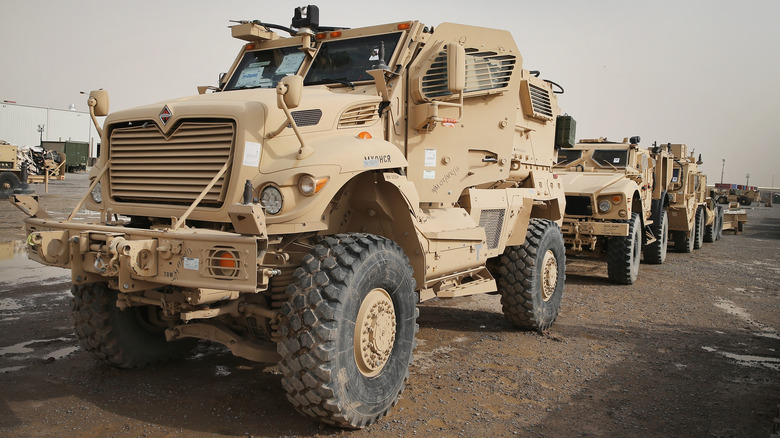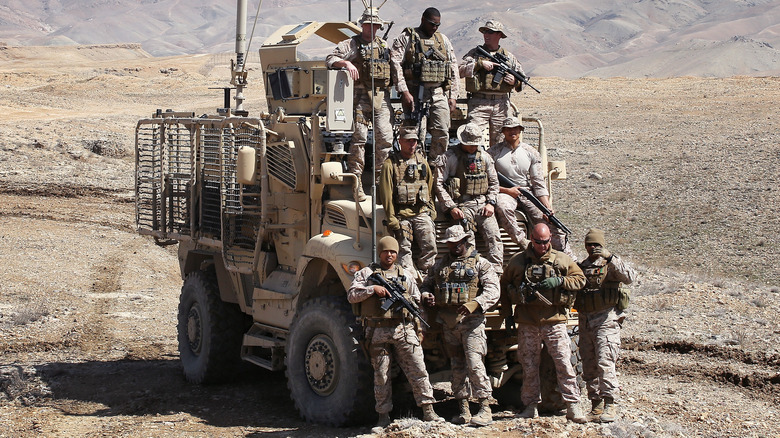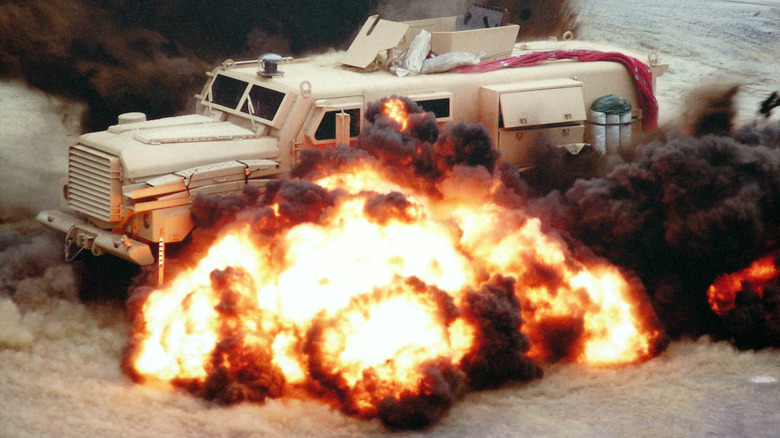The Biggest Strengths And Weaknesses Of America's MRAP
When the U.S. military went to war in Afghanistan and Iraq, it quickly became apparent that its arsenal of armored and up-armored vehicles was susceptible to dangerous improvised explosive devices (IEDs). As the war progressed, IEDs became more lethal, necessitating the development of vehicles capable of surviving such attacks, with crew protection being the principal goal. This resulted in the creation of Mine-Resistant Ambush Protected vehicles, or MRAPs.
MRAP development began in the early aughts, and since then, the U.S. military has purchased nearly 28,000 MRAPs, with 24,000 fielded in Iraq and Afghanistan. There isn't a single type of MRAP. Rather, the MRAP is a family of combat vehicles broken down into three categories, each with a different function.
Despite this, the MRAPs have common characteristics, including a v-shaped hull, a high center of gravity, and improved armor compared to other transport vehicles. Each MRAP design boasts different strengths but supports survivability over anything else. Because so many troops died as a result of IED attacks on Humvees (HMMWVs), the MRAP program was intended to save lives, and it was largely successful in this endeavor. Of course, like any complex combat vehicle, the MRAP has some weaknesses too.
MRAPs offer survivability over all else
While combat vehicles are decisive and essential to many ground operations, troops are irreplaceable. Because of this, the MRAP's design favored crew survivability over vehicle sustainment, and it worked well. The v-shaped hull and high center of gravity make most explosives incapable of penetrating the armor. The hull's design deflects explosive energy away from the cabin, while the thick armor stops most direct-fire attacks, ensuring crew survivability much of the time.
A 2011 Congressional Research Service study found that MRAPs had a casualty rate of 6%, while HMMWVs had a significantly higher rate of 22%, making the MRAP more survivable. Additionally, the MRAP's ambush protections saw fatalities from roadside attacks at 15%. In comparison, HMMWV occupants died at a rate of 80%, making the MRAP's protective features a clear-cut success. Of course, personnel protection isn't the only function an MRAP provides. It's highly versatile and capable of performing many operations.
MRAPs have gun mounts for various weapons, including a .50 caliber machine gun and the M240B machine gun. They also serve numerous functions in addition to troop transport, including operating as ambulances, supporting combat engineer activities, mine detection and removal, and explosive ordinance disposal. As they remained in the fight, the MRAP received upgrades and enhancements.
Rollover! Rollover! Rollover!
While the MRAP family of vehicles protected personnel, it possessed several notable weaknesses. Chief among them was its high center of gravity and overall vehicle height. Depending on the model, an MRAP can stand some ten feet or higher, depending on its weapon systems. This is necessary to make the v-shaped hull and IED defenses function, but it also makes MRAPs highly susceptible to rolling over. Vehicle rollovers are incredibly dangerous for occupants, and exiting a heavily armored vehicle like an MRAP when it's on the side or ceiling is precarious in the best of circumstances.
Due to the top-heavy design, the majority of MRAP accidents are rollovers. While troops train and prepare for this shortcoming as best they can, it remains a dangerous aspect of the MRAP's design. From January 2009 to July 2012, 23 fatalities and 501 injuries resulted from MRAP rollovers. The vehicle's propensity to rollover isn't its only weakness, though it's the most significant concern. In addition to rolling over, some MRAP designs weren't mechanically reliable.
MRAPs are difficult to transport due to their size, weighing between seven and 25 tons. They are also incredibly inefficient gas guzzlers. And because of their height, MRAPs are prone to electrocution from low-hanging power lines. While these weaknesses aren't minor, they're outweighed by the MRAP's combat record with reducing crew fatalities on the battlefield. Protecting the crew is the MRAP's mission, making it an effective and capable platform in current and future operations wherever they are required.
[Featured image by HSV via Wikimedia Commons | Cropped and scaled | Public Domain]


